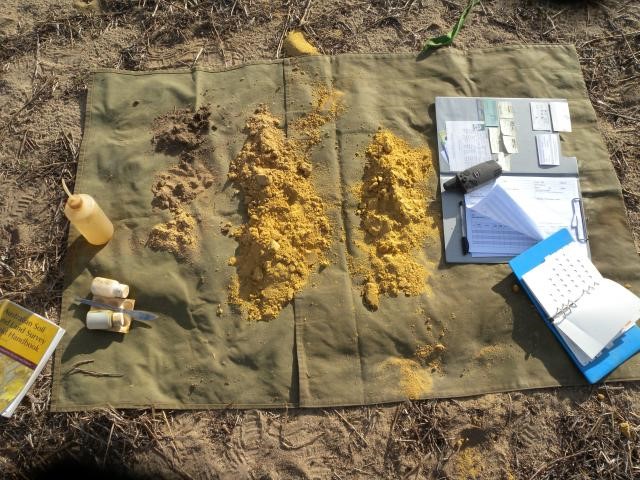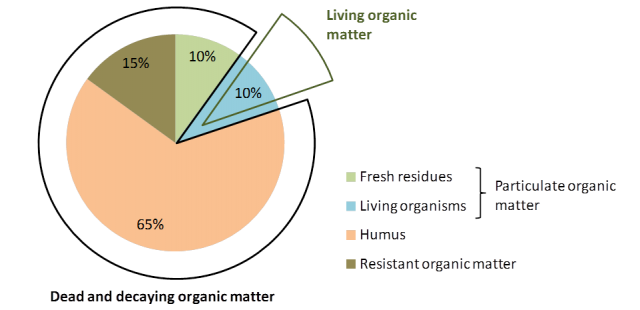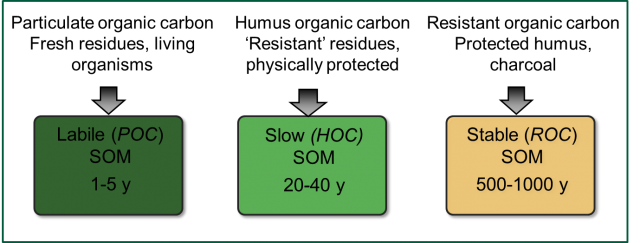What is soil organic carbon?
Soil organic carbon is a measureable component of soil organic matter. Organic matter makes up just 2–10% of most soil’s mass and has an important role in the physical, chemical and biological function of agricultural soils.
Posted on 14 Sep 2023

Organic matter contributes to nutrient retention and turnover, soil structure, moisture retention and availability, degradation of pollutants, and carbon sequestration.
How is soil organic carbon different to soil organic matter?
Soil organic carbon (SOC) refers only to the carbon component of organic compounds. Soil organic matter (SOM) is difficult to measure directly, so laboratories tend to measure and report SOC.
Soil organic carbon and carbon sequestration
Sequestering carbon in SOC has been suggested as one way to mitigate climate change by reducing atmospheric carbon dioxide. The argument is that small increases of SOC over very large areas in agricultural and pastoral lands will significantly reduce atmospheric carbon dioxide. For the reduction to be long-lasting, organic matter would have to be in the more stable or resistant fractions (Table 1). For more information see Soil organic carbon and carbon sequestration.
What is soil organic matter?
SOM is composed mainly of carbon, hydrogen and oxygen, and has small amounts of other elements, such as nitrogen, phosphorous, sulfur, potassium, calcium and magnesium contained in organic residues. It is divided into ‘living’ and ‘dead’ components and can range from very recent inputs, such as stubble, to largely decayed materials that might be many hundreds of years old. About 10% of below-ground SOM, such as roots, fauna and microorganisms, is ‘living’ (Figure 1).
SOM exists as 4 distinct fractions which vary widely in size, turnover time and composition in the soil (Table 1):
- dissolved organic matter
- particulate organic matter
- humus
- resistant organic matter.
| Fraction | Size micrometres (µm) and millimetres (mm) | Turnover time | Composition |
|---|---|---|---|
| Dissolved organic matter | <45 µm (in solution) | Minutes to days | Soluble root exudates, simple sugars and decomposition by-products. It generally makes up less than 5% of total soil organic matter. |
| Particulate organic matter | 53 µm – 2 mm | 2–50 years | Fresh or decomposing plant and animal matter with identifiable cell structure. Makes up 2–25% of total soil organic matter. |
| Humus | <53 µm | Decadal (10s to 100s of years) | Older, decayed organic compounds that have resisted decomposition. Can make up more than 50% of total soil organic matter. |
| Resistant organic matter | <53 µm – 2 mm | 100s to 1000s of years | Relatively inert material, such as chemically resistant materials or organic remnants (e.g. charcoal). Can be up to 10% of soil organic matter. |
Soil organic matter cycling
Soil type, climate and management influence organic matter inputs to soil and its turnover or decomposition. Rainfall is a major driver of plant growth (biomass) and biological activity which results in the decomposition of organic matter that enters soil. The different fractions of SOM (dissolved, particulate, humus and resistant) turn over at vastly different rates (Figure 3). Furthermore, SOM cycles continuously between living, decomposing and stable fractions in the soil (Figure 4).
Published: 28 June 2022
Author(s): Department of Primary Industries and Regional Development

